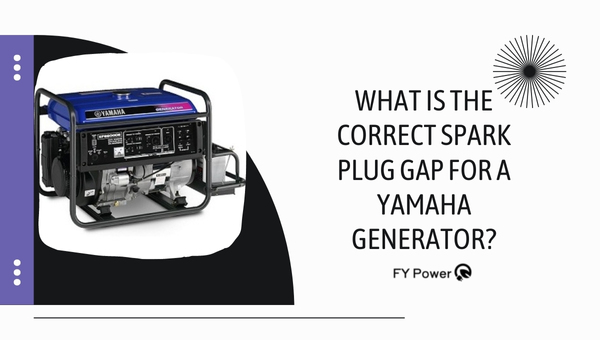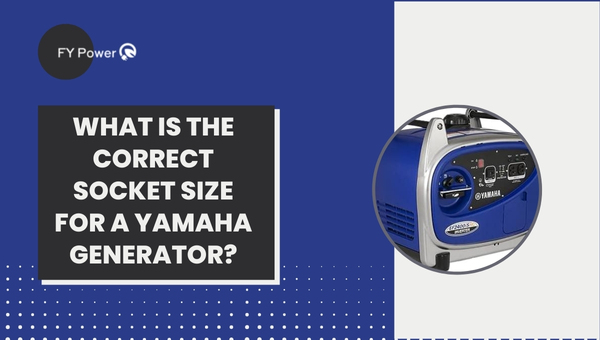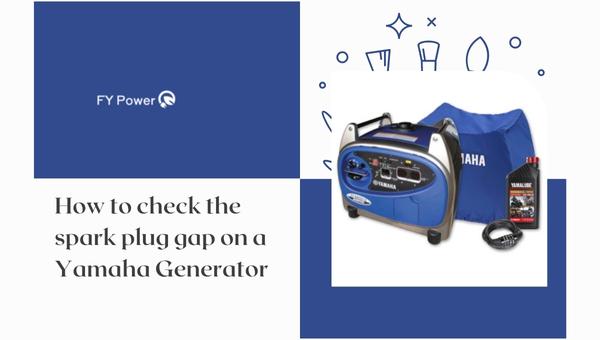Are you looking for reliable power solutions? Yamaha generators are a great choice when it comes to providing the necessary power in remote locations or during emergencies.
But before you can use your generator, there are some important details that you’ll need to know about, like spark plug gaps and socket size.
This article provides an easy-to-understand guide to determining Yamaha generators spark plug gap and socket size. We also provide helpful tips and advice on common mistakes to avoid when setting up your generator.
With this information, you can confidently set up your generator to run smoothly and efficiently every time!
What is the correct spark plug gap for a Yamaha Generator?
A Yamaha Generator’s correct spark plug gap depends on the specific model. Generally, the spark plug gap should be between 0.6-0.7 mm (0.024″-0.028″ inches).

For example, for the EF2000iS Inverter Generator, the standard spark plug is BPR6HS (NGK) with a gap of 0.6–0.7 mm (0.024″–0.028″). Additionally, some models may require a resistor spark plug with a gap of 0.030”.
What is the correct socket size for a Yamaha Generator?
When selecting a Yamaha Generator, it is important to know the correct socket size for your needs. The socket size of a Yamaha Generator varies depending on the model.

For example, the EF2000IS model has a 13/16″ (21mm) socket size, while the EF2200iS model also has a 13/16″ (21mm) socket size.
It is important to check the specifications of each generator before purchasing it in order to ensure that you have the correct socket size for your needs. Additionally, some models may require an adapter in order to use certain types of plugs.
List Of All Yamaha Generators Gap & Socket Size
1. Yamaha EF12000DE 12000 Watt Generator
- Type – BPR5ES (NGK) or equivalent
- Gap – 0.028″– 0.031″
- Socket size – 13/16″ (21mm)
- Owner’s manual – https://library.ymcapps.net
2. Yamaha EF7200DE 7200 Watt Generator
- Type – BPR4ES (NGK) or equivalent
- Gap – 0.028″ – 0.031″
- Socket size – 13/16″ (21mm)
- Owner’s manual – https://library.ymcapps.net
3. Yamaha EF7200D 7200 Watt Generator
- Type – BPR4ES (NGK) or equivalent
- Gap – 0.028″ – 0.031″
- Socket size – 13/16″ (21mm)
- Owner’s manual – https://library.ymcapps.net
4. Yamaha EF6600D 6600 Watt Generator
- Type – BPR4ES (NGK) or equivalent
- Gap – 0.028″ – 0.031″
- Socket size – 13/16″ (21mm)
- Owner’s manual – https://library.ymcapps.net
5. Yamaha EF6600DE 6600 Watt Generator
- Type – BPR4ES (NGK) or equivalent
- Gap – 0.028″ – 0.031″
- Socket size – 13/16″ (21mm)
- Owner´s manual – https://library.ymcapps.net
6. Yamaha EF6300iSDE 6300 Watt Generator
- Type – BPR4ES (NGK) or equivalent
- Gap – 0.028″ – 0.031″
- Socket size – 13/16″ (21mm)
- Owner’s manual – https://library.ymcapps.net
7. Yamaha EF5500DE 5500 Watt Generator
- Type – BPR4ES (NGK) or equivalent
- Gap – 0.028″ – 0.031″
- Socket size – 13/16″ (21mm)
- Owner’s manual – https://library.ymcapps.net
8. Yamaha EF5500D 5500 Watt Generator
- Type – BPR4ES (NGK) or equivalent
- Gap – 0.028″ – 0.031″
- Socket size – 13/16″ (21mm)
- Owner’s manual – https://library.ymcapps.net
9. Yamaha EF5200DE 5200 Watt Generator
- Type – BPR4ES (NGK) or equivalent
- Gap – 0.028″ – 0.031″
- Socket size – 13/16″ (21mm)
- Owner’s manual – https://library.ymcapps.net
10. Yamaha EF5200D 5200 Watt Generator
- Type – BPR4ES (NGK) or equivalent
- Gap – 0.028″ – 0.031″
- Socket size – 13/16″ (21mm)
- Owner’s manual – https://library.ymcapps.net
11. Yamaha EF4600A 4600 Watt Generator
- Type – BPR4ES (NGK) or equivalent
- Gap – 0.028″ – 0.031″
- Socket size – 13/16″ (21mm)
- Owner’s manual – https://library.ymcapps.net
12. Yamaha EF4500iSE 4500 Watt Inverter Generator
- Type – BPR4ES (NGK) or equivalent
- Gap – 0.028″ – 0.031″
- Socket size – 13/16″ (21mm)
- Owner’s manual – https://library.ymcapps.net
13. Yamaha EF4000DE 4000 Watt Inverter Generator
- Type – BPR4ES (NGK) or equivalent
- Gap – 0.028″ – 0.031″
- Socket size – 13/16″ (21mm)
- Owner’s manual – https://library.ymcapps.net
14. Yamaha EF3000iSEB 3000 Watt Inverter Generator
- Type – BPR4ES (NGK) or equivalent
- Gap – 0.028″ – 0.031″
- Socket size – 13/16″ (21mm)
- Owner’s manual – https://library.ymcapps.net
15. Yamaha EF2800i 2800 Watt Inverter Generator
- Type – BPR4ES (NGK) or equivalent
- Gap – 0.028″ – 0.031″
- Socket size – 13/16″ (21mm)
- Owner’s manual – https://library.ymcapps.net
16. Yamaha EF2600J 2600 Watt Inverter Generator
- Type – BPR4ES (NGK) or equivalent
- Gap – 0.028″ – 0.031″
- Socket size – 13/16″ (21mm)
- Owner’s manual – https://library.ymcapps.net
17. Yamaha EF2400iSHC 2400 Watt Inverter Generator
- Type – BPR4ES (NGK) or equivalent
- Gap – 0.028″ – 0.031″
- Socket size – 13/16″ (21mm)
- Owner’s manual – https://library.ymcapps.net
18. Yamaha EF2400iSJ 2400 Watt Inverter Generator
- Type – BPR4ES (NGK) or equivalent
- Gap – 0.028″ – 0.031″
- Socket size – 13/16″ (21mm)
- Owner’s manual – https://library.ymcapps.net
19. Yamaha EF2200iS 2200 Watt Inverter Generator
- Type – BPR6HS (NGK) or equivalent
- Gap – 0.024″– 0.028″
- Socket size – 13/16″ (21mm)
- Owner’s manual – https://library.ymcapps.net
20. Yamaha EF2000iSv2 2000 Watt Inverter Generator
- Type – BPR6HS (NGK) or equivalent
- Gap – 0.024″– 0.028″
- Socket size – 13/16″ (21mm)
- Owner’s manual – https://library.ymcapps.net
21. Yamaha EF2000iS 2000 Watt Inverter Generator
- Type – BPR6HS (NGK) or equivalent
- Gap – 0.024″– 0.028″
- Socket size – 13/16″ (21mm)
- Owner’s manual – https://www.yamahamotorsports.com
22. Yamaha EF1000iS 1000 Watt Inverter Generator
- Type – CR4HSB (NGK) or equivalent
- Gap – 0.024″– 0.028″
- Socket size – 13/16″ (21mm)
- Owner’s manual – https://library.ymcapps.net
All Predator Generators Spark Plug Gap and Socket Size Guide
How to check the spark plug gap on a Yamaha Generator
Checking the spark plug gap on a Yamaha generator is an important part of regular maintenance. Here are the steps to follow

- Determine the type of spark plug your generator uses. You can find this information in the owner’s manual or by consulting a Yamaha consumer generator dealer.
- Use a spark plug gap tool to measure the gap between the electrodes on the spark plug. The gap should be set to the manufacturer’s recommended size, which can also be found in your owner’s manual or from a Yamaha consumer generator dealer.
- If necessary, adjust the gap with a feeler gauge and then re-check it with your spark plug gap tool to make sure it is correct.
- Once you have confirmed that the gap is set correctly, reinstall your spark plug into your generator, and you are ready to go.
How to adjust the spark plug gap on a Yamaha Generator
Adjusting the spark plug gap on a Yamaha Generator is a relatively simple process. Here are the steps to follow
- Locate the spark plug on your generator and remove it from the engine. Mostly, the spark plug is located on the upper side of the engine.
- Measure the gap between the two electrodes of the spark plug using a feeler gauge or wire thickness gauge.
- If necessary, adjust the gap by bending one of the electrodes with a pair of pliers until it reaches the desired size.
- Re-install the spark plug into your generator and tighten it securely with a wrench or socket set.
- Start up your generator and check that it is running properly before use.
Guide To Predator Generator Fuel Types, Capacity & Run Time
Tips for maintaining your Yamaha Generator spark plugs
Maintaining your Yamaha generator’s spark plugs is essential for keeping it running smoothly. Here are some tips to help you keep your spark plugs in good condition.
- Check the gap size of the spark plug regularly. If it’s too wide or too narrow, replace the spark plug with one with the correct gap size.
- Clean the spark plug periodically to remove any dirt or debris that may have accumulated on it over time. Use a wire brush and compressed air to remove any buildup on the spark plug’s electrodes.
- Inspect the spark plug for signs of wear and tear, such as cracks, chips, or discoloration on its surface, every few months. If you notice any damage, replace it with a new one immediately to ensure the optimal performance of your generator engine.
- Replace your spark plugs at least once a year to ensure they work efficiently and provide maximum power output from your generator engine.
By following these simple tips, you can make sure that your Yamaha generator’s spark plugs are always in top condition and provide reliable performance for years to come.
Common problems with spark plugs on Yamaha Generators, and how to fix them?
Spark plugs are an essential part of Yamaha generators, and it is important to keep them in good condition in order to ensure reliable performance. Here are some common problems with spark plugs on Yamaha generators and how to fix them.
- Fouled Spark Plugs: Fouled spark plugs can be caused by oil or fuel contamination, which can lead to poor engine performance. To fix this problem, the spark plugs should be cleaned or replaced.
- Worn Spark Plugs: Worn spark plugs can cause misfires and reduce engine performance. To fix this problem, the spark plugs should be replaced with new ones.
- Incorrect Gap Settings: Incorrect gap settings can cause misfires and reduce engine performance. To fix this problem, the gap settings should be adjusted according to the manufacturer’s specifications.
- Damaged Spark Plug Wires: Damaged spark plug wires can cause misfires and reduce engine performance. To fix this problem, the spark plug wires should be inspected for damage and replaced if necessary.
Conclusion
Maintaining the right spark plug gap and socket size for your Yamaha Generator is essential to ensure its optimal performance.
The correct spark plug type, gap size, and alternatives can vary depending on your generator model.
It is important to check the spark plug type and gap according to the manufacturer’s manual or a reliable source.
Following these steps can help you maintain your generator’s spark plugs so that it continues to run smoothly and efficiently.

